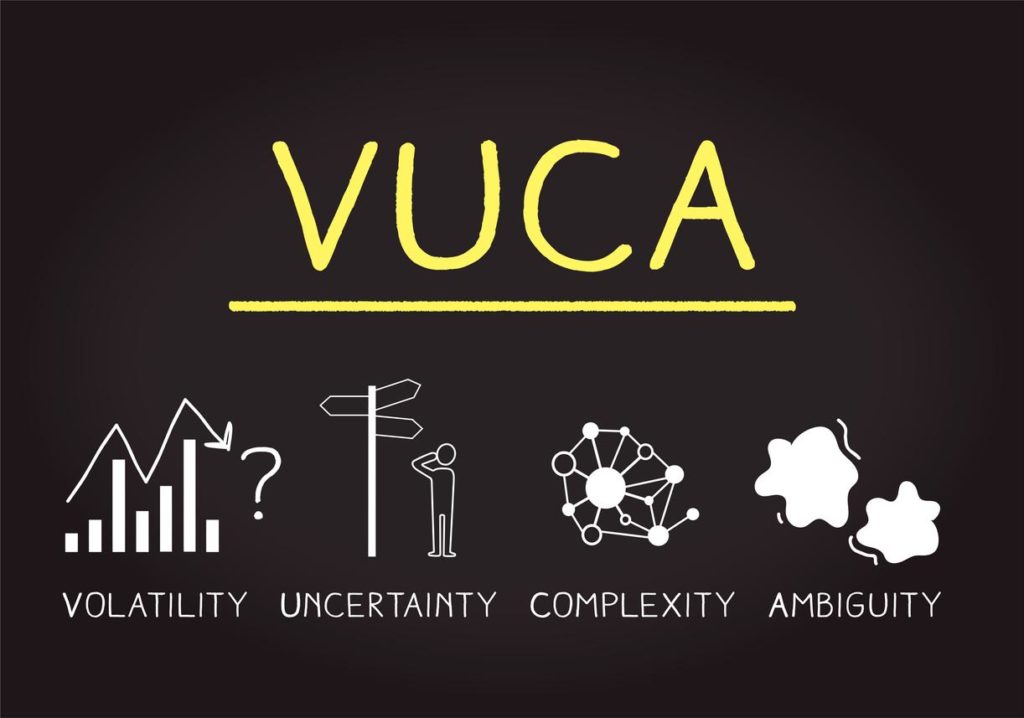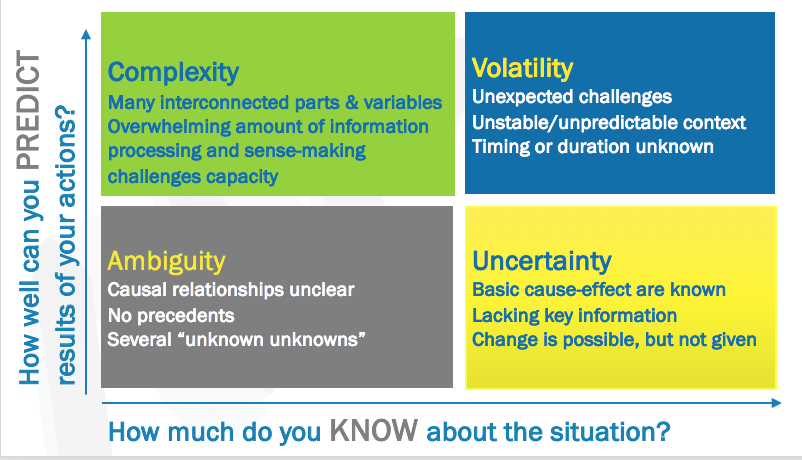
Leading Through Volatility, Uncertainty, Complexity, and Ambiguity (VUCA)
Updated 7.12.24
Over the past few years, a number of companies have asked me to help their leaders lead in the midst of VUCA. These organizations include a US-based company that is preparing for a possible, but not certain, merger and needs to continue to serve its customers, grow and innovate as it awaits approval. A European pharmaceutical company that is reorganizing to be even more responsive to the marketplace. A global financial services company that is adopting new technologies and leveraging AI to meet its increasingly tech-savvy customers’ expectations.
Most likely you are familiar with the acronym that stands for volatility, uncertainty, complexity, and ambiguity and was first used by the US Army War College to describe the contemporary battlefield. Today VUCA is widely used in the changing landscape of business.
For each of these above scenarios and many more, business success depends on the ability to compete in a rapidly changing climate.
The Agility Shift starts with expanding our understanding of what it means to be a leader.
Everybody is a Leader in a VUCA Environment
When things are changing rapidly, there is no time to run every challenge or opportunity up through the chain of command.
As I describe in The Agility Shift, “an agile leader is anyone who spots a challenge or opportunity and effectively responds.” This definition expands the understanding of leadership from the command and control model of yesterday to one focused on communication, collaboration and coordination. No longer is leadership designated by your job title, compensation package or place in the org chart. In VUCA environments, everyone is a leader. Everyone must be empowered to act to serve the customer and and generate value for stakeholders.
Which Aspect of VUCA Do You Prioritize?
To understand the leadership implications of VUCA, you need to identify which of the four characteristics are most relevant to your current situation. The matrix below, first proposed by Bennet and Lemoine (2014) may help begin to identify your leadership priorities:

VUCA Examples
Many of the examples below characterize more than one element of VUCA. I share theme to illustrate how thinking through which element is most disruptive for you and your team, or entire organization, is the first step to determining the best approach. For this reason, you could very well categorize these same events differently. More important than how you categorize them, is that you actively engage your stakeholders to make sense of your current reality.
Ambiguity
- Moving into a new market
- Launching a new product, creating a new strategic alliance
- Expanding beyond your core competencies
- Big leadership or organizational changes
Complexity
- Doing business in global markets
- Multiple stakeholders with competing or shifting priorities
- Multiple brands, products, supply chains, distribution channels
Uncertainty
- Competition is launching a new product/service and the impact on the market not known
- Merger/Acquisition MAY be on the horizon
- Proposed legislation/regulations MAY be adopted.
Volatility
- Natural disaster
- Supply chain disruption
- Labor dispute
- Technology breach
- Geopolitical instability
- PR/Ethics Scandal
Each of the four characteristics of VUCA rarely happens in isolation. For example, you might be experiencing volatility and complexity at the same time (A sudden change in leadership at the same time as your competitor launches a new product).
Think about which of these examples and characteristics, or VUCA combinations, best describes the eco-system in which you do business.
Which VUCA characteristics are most relevant to the challenges and opportunities you are confronting in your organization? Department? Your role as a leader?
Make Shift Happen
Now that you have identified the characteristics of VUCA that are most relevant to your current situation and before you start thinking about specific strategies and tactics to be effective, it is time to make the mindset shift to ensure you are setting yourself up for success.
Mindset Shift: From Planning to Preparing
In stable contexts, we can rely on the tried and true practices of planning and analysis. When the future, not to mention the present, is uncertain and unpredictable, we must make a mindset shift toward preparing and enter a state of readiness.
Just as improv performers, athletes, and SWAT teams train and prepare for various high-stakes, high-stress scenarios, you can expand your capability and capacity to be effective when things don’t go as planned.
The best practices below fall into two key and interdependent categories: 1) People and talent development strategies and 2) Systems and processes. They are interdependent because you can have the best systems and processes in the world and if you have not developed your people to make the necessary mindset and skillset shift, you will be disappointed in their performance when it counts most.
Leading Through VUCA Best Practices
As you read the following best practices for leading through VUCA, pay particular attention to those that are within your span of control or influence.
Volatility
Characterized by an unpredictable, unstable situation, though not necessarily complicated. Information is available as events unfold.
- Train for role elasticity and develop “generalizing specialists.”
- Improve decision-speed
- Build redundancy into your system and build slack into the supply chain
- Leverage technology and alternative strategies to ensure continuous communication
- Regularly train for various disruptions, and ID needed skills, knowledge, and talent
- Tap your hi-potentials for temporary assignments
Uncertainty
Characterized by a lack of key actionable information, such as timing, duration, cause and effect.
- Tap your Relational Web to:
- Reduce uncertainty
- Gather additional information and insight, including customer data, market analytics
- Improve access to market insights via resources like slack and yammer
- Reflect on and share experiences of successfully working through uncertainty
- Identify the givens of the current situation and focus on what is within your span of control
- Provide or seek career-pathing and “stay interviews” so you can identify people’s interests and strengths to keep them engaged
- Implement agile performance appraisals and regularly provide feedback and acknowledge agile success
Complexity
Characterized by an overwhelming amount of information, interconnected or moving parts and relationships.
- Improve communication, collaboration and coordination
- Clarify decision-rights
- Adapt organizational structure and expertise to match the complexity of the context
- Identify people who have strengths and experience in dealing with complexity
- Recruit and develop people who can thrive in complexity (See The Agility Shift, (See chapters 8-9 for a roadmap).
Ambiguity
Characterized by a lack of information and precedent, making the ability to predict the impact of actions a challenge.
- Create (some) clarity
- Make space for interactions
- Re-engage and recommit to your purpose
- Understand and prioritize user needs
- Focus on your MVP (Minimal Viable Product)
- Practice rapid prototyping to fail faster and learn quicker
- Experiment and pilot to discover what you don’t know
- Make time to learn the lessons from experience and carry them forward
These ideas are not intended as a prescription for the issues and opportunities that are most pressing for you and your fellow agile leaders. They will help get the conversation started and lead to thoughtful strategic and tactical approaches that build your competence, capacity, and confidence to effectively lead through VUCA.
Pamela Meyer, Ph.D. is the author of The Agility Shift: Creating Agile and Effective Leaders, Teams and Organizations. She is a sought-after keynote speaker and works with leaders and teams across industries who need innovative learning and talent development strategies to make the mindset and business shift to compete in a rapidly changing marketplace.
Bennett, J. and Lemoine, G., (2014) What VUCA Really Means for You, Harvard Business Review, January-February Issue.
